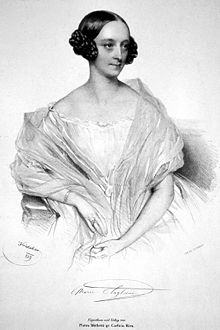Marie Taglioni
| Marie Taglioni | |
|---|---|

Taglioni in a lithograph of 1839
|
|
| Born |
23 April 1804 Stockholm, Sweden |
| Died | 22 April 1884 (aged 79) Marseille, France |
| Nationality | Italian/Swedish |
| Occupation | danseuse |
| Years active | 1824–1847 |
| Known for | La Sylphide, other romantic ballets |
| Parent(s) | Filippo Taglioni and Sophie Karsten |
| Relatives | Paul Taglioni (brother) |
Marie Taglioni (23 April 1804 – 22 April 1884) was a ballet dancer of the Romantic ballet era, a central figure in the history of European dance. She was one of the most celebrated ballerinas of the romantic ballet, which was cultivated primarily at Her Majesty's Theatre in London, and at the Théâtre de l'Académie Royale de Musique of the Paris Opera Ballet. She is credited with (though not confirmed) being the first ballerina to truly dance en pointe.
Taglioni was born in , Sweden, to Italian choreographer Filippo Taglioni and Swedish ballet dancer Sophie Karsten, maternal granddaughter of the Swedish opera singer Christoffer Christian Karsten and of the Polish opera singer and actress Sophie Stebnowska. Her brother, Paul (1808–1884), was also a dancer and an influential choreographer; they performed together early in their careers.
Taglioni was married to Comte Auguste Gilbert de Voisins on 14 July 1832, but separated in 1836. The couple had one daughter, Eugenie-Marie Edwige.
Taglioni moved to Vienna with her family at a very young age where she began her ballet training under the direction of her father. Filippo created a rigorous training regimen for his daughter that consisted of holding positions for 100 counts and engaging in two hour long intervals of conditioning exercises, adagio, and jumping combinations. In Vienna, Marie danced her first ballet choreographed by her father titled "La Reception d'une Jeune Nymphe à la Cour de Terpsichore".
Before joining the Paris Opéra, Taglioni danced in both Munich and Stuttgart, and at age 23 debuted in another ballet choreographed by her father called "La Sicilien" that jump-started her ballet career. Taglioni rose to fame as a danseuse at the Paris Opéra when her father created the ballet La Sylphide (1832) for her. Designed as a showcase for Taglioni's talent, it was the first ballet where dancing en pointe had an aesthetic rationale and was not merely an acrobatic stunt, often involving ungraceful arm movements and exertions, as had been the approach of dancers in the late 1820s.
...
Wikipedia
